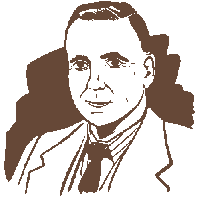People Profiles |
|||||||||||||||||||||||

|
|
|
|||||||||||||||||||||
|
Dr. Ferguson’s training in theology, economics and medicine, as well as his labors on the farm, all contributed to his skills in running a sanatorium and in getting people to work together. His management skills and knowledge of economics helped in the early stages of construction as well as during the depression years, while his training in theology helped many patients to face the end with fortitude and grace. Veterans at the San, with encouragement from Dr. Ferguson began the Valley Echo, the Sanatorium magazine.
Dr. Ferguson tried to instill in his patients "that ’the cure’ is not a bottle of medicine, nor a surgical operation, but an idea; a way of life to apply to every moment of the day, every activity." A spirit of cheerfulness, good humor kindliness and forbearance was also part of the cure. It was this new way of life – plenty of rest, good food, fresh air and hopefulness, as well as goad personal hygiene to prevent the spreading the disease – which Dr. Ferguson was attempting to teach. There was no magic cure, but rather it took months and years of treatment to effect a recovery. Long-term sanatorium treatment was too expensive for most sufferers, so Dr. Ferguson attempted to teach a new way of life, which could be followed at home. The Vision "When we think of the future of this institution we do not think of its building and equipment, but rather of an idea, a force, a group of associations and a locality with its hopeful traditions, glowing with prestige and confidence in the cure of the disease. We would like to think of it as a medical centre, where is available every facility for the diagnosis and treatment of tuberculosis, where a sick man may get every chance to regain his broken health and return to a sphere of usefulness as a citizen. We want it to be an educational centre where the facts about a disease are being accumulated for public use; a centre where sufferers may come to get an education in regard to a disease, may learn its cure and prevention. Last of all, we want it to have the atmosphere of a home where those who have fallen ill with the disease may come to rest and receive the encouragement and direction necessary to win a hard fight." – R. G. FERGUSON, M.D. (1917) on the opening of the Ft. Qu’Appelle San, reprinted in the 1964 Valley Echo [volume 45(3), page 3]In 1928 Dr. Ferguson presented a paper Tuberculosis among the First Nations people of the great Canadian Plains to the fourteenth annual conference of the National Association for the Prevention of Tuberculosis in London, England. His reputation as an authority on tuberculosis was established and he was acknowledged as a leader in the field of tuberculosis control. By 1930, under his leadership, Saskatchewan had gained worldwide recognition in tuberculosis control and prevention.
In 1938 Dr. Ferguson introduced BCG vaccination to protect student nurses at the Fort Qu’Appelle Sanatorium. This was another first for Saskatchewan. In recognition of this pioneer work and its great success, he was appointed in 1948 a member of the Sub-Committee on Tuberculin and BCG of the World Health Organization. This was one of his many appointments to national and international committees. Another outstanding first for the province of Saskatchewan under the direction of Dr. Ferguson was the introduction of mass x-ray surveys of entire communities. This revolutionary step put Saskatchewan in the lead in world tuberculosis prevention. In addition to preparing twenty-two valuable and comprehensive articles for publication, Dr. Ferguson wrote a book, "Studies in Tuberculosis," which was published in 1955. -- modified from Wherrett in The Miracle of the Empty Beds, 1977. | |||||||||||||||||||||||



